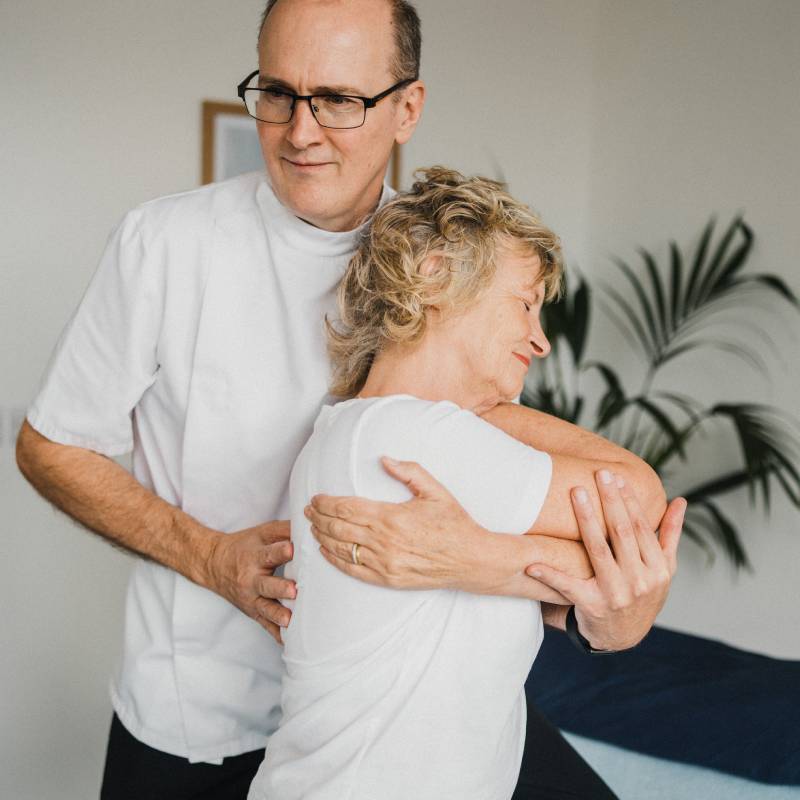You may be looking to book an appointment with an osteopath because you’ve suffered a sports injury, are recovering from surgery, or have chronic pain as a result of an old trauma or current lifestyle. Our osteopaths are fully trained and highly experienced professionals who treat each person as an individual, taking care to understand the whole picture and tailoring treatment to you as a person. But have you ever wondered what to expect at your osteopathy appointment? How to prepare for your session and what’s covered in your initial, and follow-up treatments?
In this blog, osteopath Nicola Bayer from our Staines clinic covers those questions. But first, let’s get clear on what an osteopath does and how they are qualified to treat you.
What does an osteopath do?
Nicola says “As an osteopath, I work to restore your whole body to a state of balance. Through techniques such as touch, physical manipulation, stretching and massage I and my colleagues will support the increased mobility of joints, relief of muscle tension, boosting the blood and nerve supply to tissues, and to aid the innate healing mechanisms of your own body. As part of your treatment, we may also offer advice on posture and exercise to support recovery and prevent the recurrence of pain and other symptoms.”
The General Osteopathic Council defines osteopathy this way, “Osteopathy is a system of diagnosis and treatment for a wide range of medical conditions. It works with the structure and function of the body and is based on the principle that the well-being of an individual depends on the skeleton, muscles, ligaments and connective tissues functioning smoothly together.”
What qualification does an osteopath have?
Osteopaths complete a 4- or 5-year honours degree programme (bachelor’s or master’s), which includes a minimum of 1,000 hours of clinical training. Some osteopaths are further qualified to PhD level. All osteopaths in the UK are regulated by the General Osteopathic Council (GOsC).
Osteopaths are required to renew their registration with the GOsC each year, and on registration they receive an annual licence to practise. In checking suitability to practice, the GOsC requires that osteopaths have current professional indemnity insurance, remain in good health and of good character, and have met mandatory continuing professional development requirements.
The title ‘osteopath’ is protected by law. It is illegal for anyone to call themselves an osteopath in the UK unless they are registered with the GOsC.
Can my doctor refer me to an osteopath?
Most osteopaths work in the private sector, and some offer their services through the NHS. Increasingly, osteopaths are working alongside GP practices to make cross-referrals.
In some areas, doctors can refer patients to an osteopath for treatment which is funded by the NHS. To find out whether osteopathic treatment is available on the NHS in your area, contact:
- your local Clinical Commissioning Group if you live in England
- your local Health Board if you live in Scotland
- your local Health Board if you live in Wales
- your local Health and Social Care Board if you live in Northern Ireland
Your first osteopathy appointment
Osteopathy is a patient-centred system of healthcare, meaning that your osteopath will take the time to understand you, your lifestyle and your presenting complaint.
A first appointment with an osteopath usually lasts longer than subsequent appointments. This allows time for your practitioner to:
• Listen to your presenting complaint and ask questions about this as well as your general health, other medical care you are receiving or medication you are taking; and record this in your case notes. All information you provide will be confidential.
• Examine you thoroughly. You may be asked to remove some of your clothing to facilitate this. Always let your osteopath know if you feel uncomfortable about this. You will have privacy to undress, and a gown or towel may be offered. You can ask a friend or relative to accompany you during your treatment.
• Ask you to make simple movements and stretches, to observe your posture and mobility. Because of the body’s structure, pain or stiffness you are experiencing in one area may be linked to a problem elsewhere.
• Examine the health of the joints, tissues and ligaments using their hands and a highly developed sense of touch called palpation.
• Check for signs of other serious conditions they cannot treat and advise you to see your GP or go to hospital. They should provide you with a letter outlining the nature of the problem.
Your follow-up sessions with an osteopath
Following your first consultation, your osteopath will provide a clear explanation of what they find (their diagnosis) and discuss a treatment plan they think might be best for you. As part of that discussion, your osteopath will explain the benefits along with any risks of the proposed treatment. You will receive an estimate of the number of sessions needed for improvement in your condition.
Treatment is hands-on and includes careful and skilled manipulation of the spine and joints, as well as massage of soft tissues. Your osteopath will explain what they are doing and will request your consent. If you have questions or concerns, do raise them with your osteopath at any time.
Finally, your osteopath will usually offer advice on exercise and any other measures you can take to support your recovery and prevent a recurrence or worsening of symptoms.
Book your osteopathy appointment now
It couldn’t be easier to book your osteopathy appointment with Osteo & Physio! Book a session via our app, website or call our friendly reception team on 0345 5577788.

